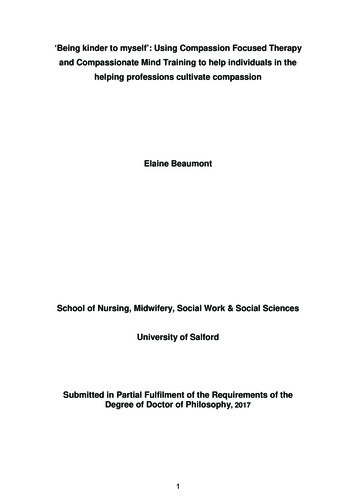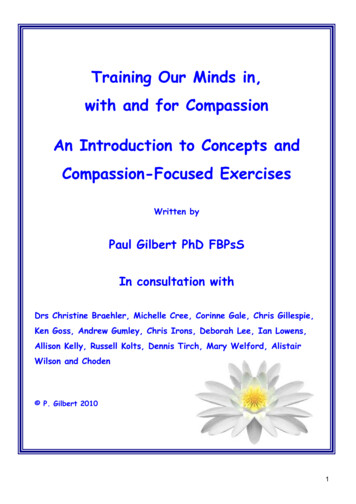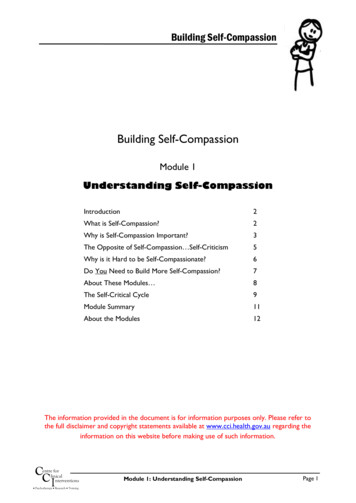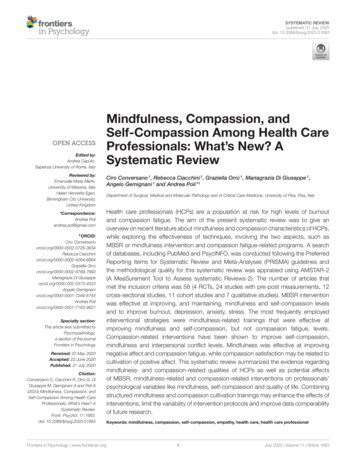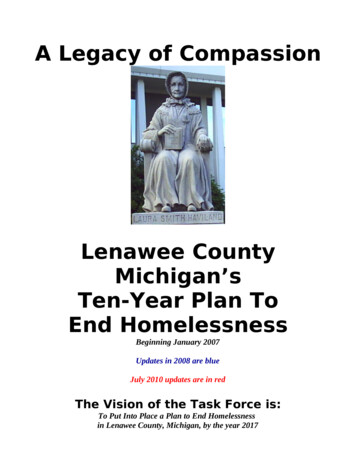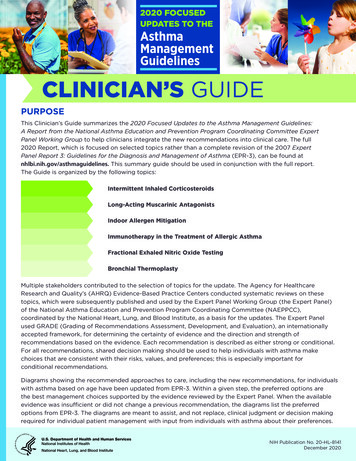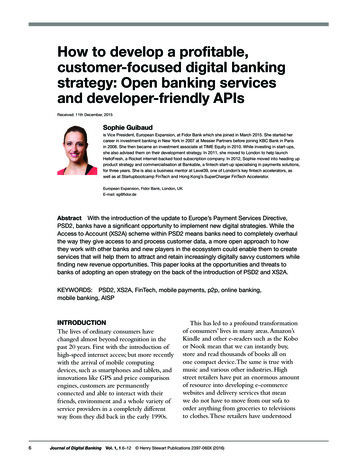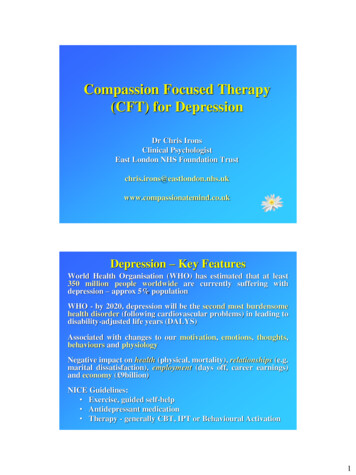
Transcription
Compassion Focused Therapy(CFT) for DepressionDr Chris IronsClinical PsychologistEast London NHS Foundation emind.co.ukDepression – Key FeaturesWorld Health Organisation (WHO) has estimated that at least350 million people worldwide are currently suffering withdepression – approx 5% populationWHO - by 2020, depression will be the second most burdensomehealth disorder (following cardiovascular problems) in leading todisability-adjusted life years (DALYS)Associated with changes to our motivation, emotions, thoughts,behaviours and physiologyNegative impact on health (physical, mortality), relationships (e.g.marital dissatisfaction), employment (days off, career earnings)and economy ( 9billion)NICE Guidelines: Exercise, guided self-help Antidepressant medication Therapy - generally CBT, IPT or Behavioural Activation1
Compassion Focused Therapy (CFT)Origins and Key Features:Professor Paul GilbertClients with chronic, complex depressions, with high shameand self-criticism“I know what you’re saying, but I just don’t feel it ”Based on science of mind – evolution, neuroscience, social anddevelopmental psychologyCompassion begins with a reality checkWe are an emergent species in the ‘flow of life’ soour brains, with their motives, emotions andcompetencies are products of evolution, designed tofunction in certain waysOur lives are short (25,000-30,000 days), decay andend, and are subject to various malfunctions anddiseases – in a genetic lottery. Everything changes –the nature of impermanence – the nature of tragedyThe social circumstances of our lives, over which wehave limited control, have major implications forthe kinds of minds we have, the kind of person webecome, the values we endorse, and the lives we live2
Gene and Life Stress InteractionProbability of major depressionepisode(from Caspi et al., 2003; cited by Rutter)s/s short allele homozygouss/l heterozygousl/l long allele homozygous.50s/s.40s/l.30l/l.20.10.0001234 More depressedLess depressedNumber of stressful life events3
Less depressedMore depressedInteractionSourcesof old andpsychologiesof newbehaviourMindful BrainNew Brain:Imagination, Planning, Rumination,ToM, MentalisationOld Brain:Motives (food, sex, relationship seeking, caring, status)Emotions (anger, anxiety, sadness, joy)Behaviours (fight, flight, shut down etc)COMPASSION4
So, Basic Philosophy is That:We all just find ourselves here with a brain, emotions andsense of (socially made) self we did not choose but have tofigure outLife involves dealing with tragedies (threats, losses,diseases, decay, death) and people do the best they canMuch of what goes on in our minds is not of ‘our design’and not our faultWe are all in the same boatDe-pathologising and de-labelling – understanding uniquecoping processes and how evolution has led to us having‘tricky’ mindsHow are our motives and emotionsorganised?Motives evolved because they help animals to survive,seek out things that are important (e.g. food, shelter,relationships, status, reproduction etc) and leave genesbehindEmotions guide us to our motivations/goals andrespond if we are succeeding or threatenedThere are three types of emotion regulation systems1. Those that focus on threat and self-protection2. Those that focus on doing and achieving3. Those that focus on contentment and feeling safe5
Emotion Regulation Systems:– ‘Three Circle’ ModelContent, Safe, SoothedDrive, Excite, VitalityNon-wanting/Affiliative focusedIncentive/resourcefocusedWanting, pursuing,achieving, e?Threat-focusedProtection and Safety-seekingThoughts, Emotions, BehaviourSerotonin?Anger, Anxiety, DisgustEmotion Regulation Systems:– ‘Three Circle’ ModelThreat-focusedProtection and Safety-seekingHPA/Serotonin?Anger, Anxiety, Disgust6
7
8
Emotion Regulation Systems:– ‘Three Circle’ ModelDrive, Excite, VitalityIncentive/resourcefocusedWanting, pursuing,achieving, consumingDopamine?Threat-focusedProtection and Safety-seekingHPA/Serotonin?Anger, Anxiety, Disgust9
10
11
Types of Affect Regulation SystemsDrive, excite, vitalityContent, safe, connectedNon-wanting/Affiliative anting, pursuing,achieving, ne?Threat-focusedProtection andSafety-seekingActivating/inhibitingAnger, anxiety, disgustDispersal and avoid others12
13
How inareCFTthe threeoftenAimfor systemsdepression?balanced for many people duringBalance depression?One aim of CFT?.BalanceContent, Safe, SoothedDrive, Excite, VitalityNon-wanting/Affiliative focusedIncentive/resourcefocusedWanting, pursuing,achieving, ?Threat-focusedProtection and Safety-seeking(Behaviours, Emotions, Thoughts)Serotonin?Anger, Anxiety, Disgust14
Relationship between Threat minationCFT - Key IdeasVarious therapies (e.g. CBT) have developed exposure and othertechniques for toning down negative emotions but not for toningup certain types of positive ones.Can’t assume that by reducing negative emotion the positives will‘come on line’Two types of positive affect related to:- achievements/doing/excitements (drive system)- affiliation, affection, soothing (affiliative/soothing system)Some clients have major difficulties in being able to access theaffiliative/soothing system - implications - so CFT targets thissystem along with the other systems therapy traditionallytargeted15
Compassionfrom the Latin com - with patī to bear, sufferWhat is Compassion?Darwin – saw sympathy as the strongest of human evolvedemotions:“those groups with most sympathetic member were likely toflourish the most and rear the most number of offspring”Descent of Man, and Selection in Relation to Sex (1871, p130)Keltner – three factors: Enhances welfare of vulnerable offspring Desirable emotion in mate selection Enables cooperative relations with non-kinKey: link to the caregiving, affiliative and attachment systemWei et al (2011)Attachment Anxiety r -.38** Attachment Avoidance r -.36**16
What blocks compassion?17
What do we need to feel compassion?What is Compassion?Common definition:“a sensitivity to the suffering of self and otherswith a deep commitment to try to relieve it”From CFT perspective, compassion linked to twovery different psychologies, which we aim to develop:(1) the ability to engage with suffering and distress(2) The desire and motivation to alleviate suffering,uproot it’s causes and seek to prevent suffering in thefuture18
(i) First Psychology of Compassion:- EngagementBeing open and receptive to suffering, andwilling to move towards and engage with it not avoiding or shutting it outIn CFT, a number of key ‘compassion’attributes are seen as important so that wecan move towards and engage withsuffering?Compassionate Mind - EngagementATTRIBUTESWarmthSensitivityCare WarmthEmpathyDistresstoleranceWarmth19
(ii) Second Psychology ofCompassion: - AlleviationDrawing upon inner resources of wisdomand compassion through which we try ourbest to alleviate sufferingIn CFT, we seek to help people to learnspecific skills to build these inner resourcesso that we can effectively alleviatesuffering?Skills developed via therapy interventionsAttention:On what is/was helpful and what is needed –movable, ‘zoom in’ and ‘zoom out’ perspectiveFeelings:Cultivation of loving kindness, warmth, openaffiliation, patience, slowingReasoning: Evidence, alternatives and ‘not my fault’understandingBehaviour: Commitment to practice, effort, courage –actionImagery:Sensory:Different forms (based on memory, or creating‘fantasy’ image) bringing into mind, using tointegrateBreathing, body posture, voice tones, Yoga20
Compassion Focused Therapy – AlleviationSKILLS pathySensitivityCare rmthCFT Can Involve:The therapeutic relationship, collaboration, guided discovery,personal meaning, Socratic dialogues, inference chains –(bottom line/catastrophe/major fear/threat), functional analysis,chaining analysis, maturation awareness, shared formulation,change through practice, behavioral experiments, exposure,developing emotional tolerance, mindfulness, guided imagery,expressive writing, reframing, generating alternative thoughtsand independent out-of-session practice -- to name a few!There shouldbe increasing overlaps in our therapies if weare being science based21
What makesCompassion Difficult?Fears, Blocks and Resistances (FBRs)Fear of CompassionCertain types of positive feelings are threateningIt is dangerous to feel safeCompassion feeling are linked to beliefs such ascompassion is an indulgence and is weaknessActivated grief and or abuse memories22
Fear of Compassion ScaleGilbert et al (2010), Psychology and PsychotherapyFear of Compassion for Others ScaleCompassion makes you weak, others will take advantage of you(“people will take advantage of you if you are toocompassionate”)Compassion for others will create dependency in others (“if I’mtoo compassionate, others will become too dependent on me”)I can’t tolerate others’ distressFear of Compassion from Others ScaleFear of availability/how genuine compassion from others is (“Ifear that if I need other people to be kind, they wont be”)Fear of closeness (“if I think someone is being kind & caringtowards me, I put up a barrier”)Fear of Compassion towards SelfScaleFear of losing self-criticismI fear that if I develop compassion for myself, I willbecome someone I don’t want to beFear of grief/emptiness when try to feel compassionI fear that if I start to feel compassion for myself, I will beovercome with loss/grief23
Fear of Compassion DataCompassionfor OthersCompassionfrom OthersSelfcompassionCfromO.54**Self 1**CFT – Treatment EvidenceGilbert & Proctor (2006), Clinical Psychology and Psychotherapy Attendance one of two programmes Patients invited to take part in a research trial of CMT atcommunity meetings Criteria for inclusion were mid treatment (six months toone year), well engaged with the service and to have selfattacking, negative thoughts Nine patients agreed to take part in the study (five men andfour women) Three did not complete the study: hence six completed Twelve two hour sessions Gradual process of developing compassionate imagery andsoothing exercises and then engaging with self criticalthinking24
Data From Group StudyPre and Post Compassionate M elf criticismSelf compassionData From Group 086.83(2.93)Bef ore4.3(2.73)6Af ter420AnxietyDepressionSubs cale25
Why Compassion? - DataPractice of imagining compassion for others produces changes infrontal cortex & immune system (Lutz et al, 2008)Macbeth and Gumley (2012) – meta analysis of studies looking at selfcompassion (SCS) and psychopathology (depression and anxiety).Found large effect size or r -.54Studies looking at how self-compassion iscorrelated with depression (threat system):– Self-compassion and self-criticism– Self-compassion and rumination– Self-compassion and worryrelated to factors oftenr - .65** (Neff, 2003)r - .50** (Neff, 2003)r - .62*** (Raes, 2010)Breines & Chen (2012) found self-compassion group, in comparison toself-esteem group, had: greater motivation to make aments for a moral transgression more time studying for a difficult test following an initial failure greater motivation to change a perceived weaknessDataRaes (2011) – self-compassion scores at T1 predicted likelihood ofdepression at T2 five months later in studentsVan Dam et al. (2011) – self-compassion a stronger predictor ofdepression symptomology than mindfulnessKuyken et al. (2010) – mindfulness based cognitive therapy (MBCT)effectiveness for depression was partly through increasingparticipants self-compassion.Neff and Germer (2012) – non-clinical RCT of 8-week Mindful SelfCompassion (MSC) course, found significant improvements intreatment group over wait list control on measures of self-compassion,mindfulness and well-being (depression, anxiety, stress). Theseimprovements were maintained at 6 and 12-month follow up.26
Care For Well-Being:What Do You Wish to Be?There is a story attributed to Native American wisdom, thatlinks nicely to how we might ‘see’ different parts of us:One evening a grandfather was teaching his young grandsonabout the internal battle that each person faces.“There are two wolves struggling inside each of us,” the oldman said. “One wolf is vengeful, angry, resentful, self-pityingand scared the other wolf is compassionate, faithful, hopeful,and caring.”The grandson sat, thinking, then asked: “Which wolf wins,Grandfather?”His grandfather replied, “The one you feed.”27
Gilbert et al (2010), Psychology and Psychotherapy Fear of Compassion for Others Scale Compassion makes you weak, others will take advantage of you (“people will take advantage of you if you are too compassionate”) Compassion for others will create dependency in others (“ifI’m too compassionate, others will become too dependent on me”)
